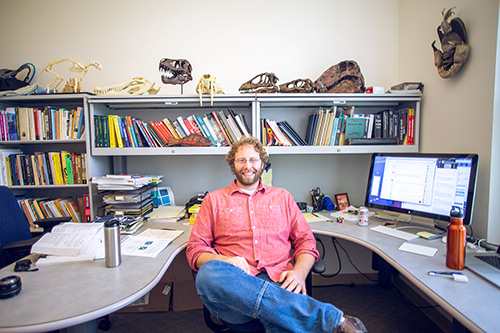One of the campus’s newest professors is teaching one of its newest classes on one of the world’s oldest subjects: dinosaurs.
But there’s much more to Professor Justin Yeakel’s Natural History of Dinosaurs class than just talking about T-rex and the velociraptors.
 Yeakel, with the School of Natural Sciences, is an ecologist who’s interested in how animals find and acquire food, and how that changes and affects animal populations and communities over time.
Yeakel, with the School of Natural Sciences, is an ecologist who’s interested in how animals find and acquire food, and how that changes and affects animal populations and communities over time.
He wants students to understand those ancient ecosystems because looking at the past is a way to understand — and perhaps mitigate for — the future.
Even though Yeakel is a biologist, he studies the past as well.
“It’s becoming more common for researchers to bring methods and perspectives from different disciplines to their work,” Yeakel said. “For example, we recently reconstructed the pattern of extinctions among mammals in Egypt over the past 10,000 years using evidence of species’ occurrence that we obtained from historical artwork.”
Ancient art provides clues to the sequence of extinctions and documents the coinciding downfalls of ancient civilizations, which tend to occur during episodes of intense drought or aridification.
“Food becomes scarce for everyone,” Yeakel said.
Through the research, he learned that historical Egypt had more than 30 species of mammals — including most of the major East African ones, such as lions, giraffes, water buffalos and cheetahs. There are only eight species of mammals in Egypt today.
“When an ecosystem is large, it can generally recover after losing one or two species. But the fewer you have, the fewer you can afford to lose,” Yeakel said. “As extinctions accumulate, the more unstable ecosystems become. We actually want ecosystems to be too big to fail.”
In general, species don’t last long in the big scheme of the world. For mammalian species, 1 million to 2 million years is about all, he said. But not all extinctions happen naturally.
He’s also mapping the changes in the northwest Atlantic Ocean community.
“Even 200 to 300 years ago, that area had abundant great white sharks, walruses and so much more,” Yeakel said. “It’s one of the most human-impacted areas on the planet.”
He’s also collaborating with fellow Professor Jessica Blois on a project to reconstruct the mammalian communities in and around the area now called the La Brea Tar Pits. Recently, scientists discovered the fossils of many smaller mammals there among the large bones of mastodons and saber-tooth cats, offering a more nuanced perspective on a classic Pleistocene ecosystem.
He hopes that by looking at the past, we can figure out ways to conserve what we have left and, perhaps, help ourselves and our fellow creatures to thrive despite the changes that are coming.
He hopes students in the dinosaur class will not only enjoy his cool models of dinosaur fossils, but also see the class as “a gateway to science.”
“It unites many areas of science,” Yeakel said. “It covers dinosaurs and other prehistoric life. We spend the first few weeks understanding what came before the Mesozoic Era. That’s a time period I’ve been interested in since I was 6 years old. It’s amazing to think of that world. I would love to have seen it.”



